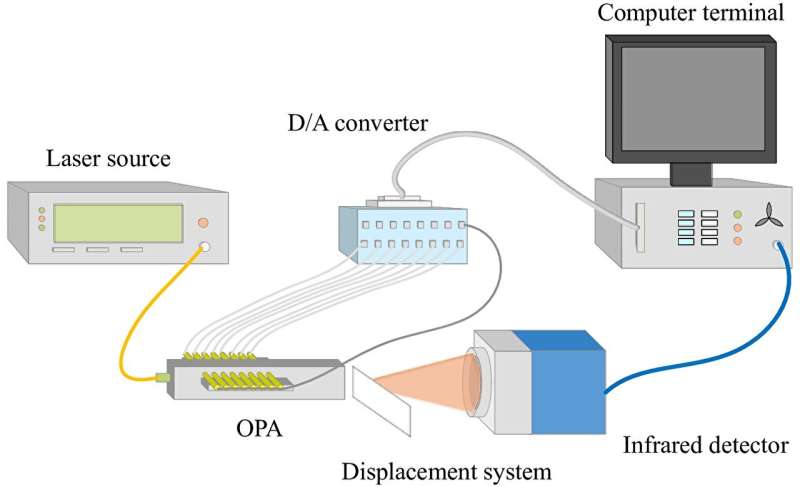This article has been reviewed according to Science X's editorial process and policies. Editors have highlighted the following attributes while ensuring the content's credibility:
fact-checked
proofread
Scientists realize optical phased array calibration via pointwise optimization

An optical phased array (OPA) is a nonmechanical beam-steering control device with high directivity and deflection efficiency. Due to its high resolution, fast response, and absence of inertia, the OPA is widely applied in LiDAR, free-space optical communication, multi-beamforming and many other fields.
Limited by the manufacturing level, the accumulation of structural errors degrades the quality of the deflection beam. In addition, the random phase noise induced by fabrication factors results in angular deviation and low energy efficiency.
Researchers have optimized the far-field distribution to improve the OPA's performance in beam steering, focusing, and energy efficiency. The phase distribution of the wavefront is acquired using a phase sensor or phase recovery algorithm. However, it is challenging to construct a complicated system for optical path adjustment and light field acquisition.
In a new paper published in Light: Advanced Manufacturing, a team of scientists led by Professor Mingjie Sun from Beihang University has proven a phase-calibration optical system both theoretically and experimentally.
Recently, phase-calibration approaches based on adaptive optics have been the focus of OPA-related investigations. This approach no longer requires phase detection and reconstruction of the wavefront and directly optimizes the voltage of each element to obtain the optimal beam deflection efficiency. Such adaptive optimization approaches include simulated annealing algorithm, genetic algorithm, and rapid search algorithm and have simple experimental setup and calculation.
The commonly used approach applies the Stochastic Parallel Gradient Descent (SPGD) algorithm to optimize the wavefront's shape, which improves the performance of multi-channel processing and reduces the constraints on the objective function. However, when the number of array elements increases, the optimization can be easily trapped at a local minimum owing to the nonconvex nature of the optimization, and the convergence speed of the evaluation function decreases significantly.
To address this problem, the research team proposes an alternative approach for performing rapid and accurate beam deflection of the OPA. This approach conducts phase calibration individually for each array element using carefully designed mechanics. Subsequently, based on this method, the far-field diffraction efficiency of the OPA steadily increases, and the theoretical limit is obtained linearly and deterministically.
The results of numerical simulations and experiments demonstrate that, compared to a typical SPGD algorithm, the proposed pointwise optimization approach increases the convergence rate by 53.5% while decreasing the time consumption by 9.7%. It indicates that the pointwise optimization approach combines the characteristics of global search and accurate calibration in different parts of the calculation process, thus reducing the number of iterations and improving the convergence speed.
The proposed simulation and experimental results demonstrate that the pointwise calibration approach achieves rapid and precise phase calibration. With the help of carefully designed mechanics, the pointwise calibration approach realizes the selection of different elements. It is a type of deterministic approach that improves the diffraction efficiency of the OPA. It combines the characteristics of global search and accurate calibration and significantly decreases the number of iterations. Proper division in the phase calibration process also reduces the computational cost.
Compared with the typical adaptive optical approach, the proposed pointwise calibration approach still shows excellent convergence rate and energy efficiency performance. The experimental result of the pointwise calibration approach is much closer to the simulation data, indicating its advantage in robustness.
In conclusion, the pointwise optimization approach is efficient and reliable for improving beam steering and focusing. The proposed approach performs rapid and deterministic phase calibration using a pointwise and segment correction process, which can be potentially cost-effective and high-performance OPA. This approach has shown practical value in autonomous vehicles and LiDAR.
More information: Jingwen Shan et al, Fast and deterministic optical phased array calibration via pointwise optimisation, Light: Advanced Manufacturing (2023). DOI: 10.37188/lam.2023.010
Provided by TranSpread





















